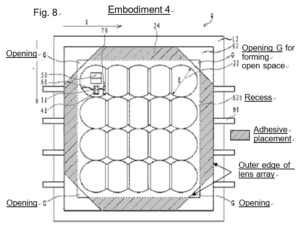Japanese Patent Case Summary: 2023 (Gyo-Ke) No. 10145 –Intellectual Property High Court (July 10, 2024)
“Light-Emitting Device”
Overview:
The decision to dismiss the appeal against the final rejection was upheld, stating that there was no error in the judgment that the amendment related to claim 2 constituted an addition of new matter.
►Link to a summary and full text of the trial decision (Japanese)
Main Issue:
Whether the feature, “the open space is formed by the adhesive being disposed between the sealing member and the lens member, without annularly encircling the outer edge of the lens member,” which is an amendment related to claim 2 (hereinafter, “amendment to claim 2”) is an addition of new matter.
Summary:
Since in the amendment to claim 2,…the open space is formed “by the adhesive being disposed… without annularly encircling the outer edge of the lens member (placement of the adhesive in this case),” it is understood that the placement of the adhesive in this case contributes to the formation of the open space. …it will be considered…whether the point above can be said to be a technical matter derived from the comprehensive review of the entire disclosure of the original specification and the like.
The disclosure relating to Embodiment 4 in the original specification and the like will be considered.
It is understood from the relationship in Fig. 8 between the outer edge of the lens array 20 and the region in which the lens array 20 is fixed to the sealing member 80 by the adhesive that the adhesive does not annularly encircle the outer edge of the lens member in Embodiment 4. Thus, the placement of the adhesive in this case is a matter that is apparent from Fig. 8.
However, according to the disclosure of the original specification and the like…, in the disclosure relating to Embodiment 4, the open space is formed by the positional relationship of positioning a part of the outer edge of the lens array 20 inside the recess 82b, where the placement of the adhesive is not an issue in the first place.
As described above, even when the entire disclosure of the original specification and the like is comprehensively reviewed, it is not possible to derive the technical matter that the placement of the adhesive in this case contributes to the formation of the open space.

Comments:
The judgment recognized that “the placement of the adhesive in this case contributes to the formation of an open space” as the intent of the amendment to claim 2, but ruled that such a technical matter cannot be derived from the disclosure of the original specification and like. In making this determination regarding the addition of new matter, the method of first recognizing the intent of the amendment, then applying and assessing it against the disclosure of the original specification and the like may be helpful.
Yuuji WADA